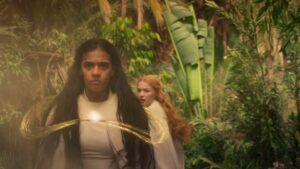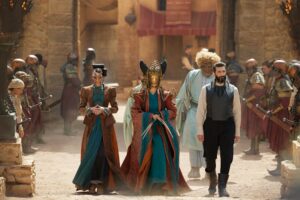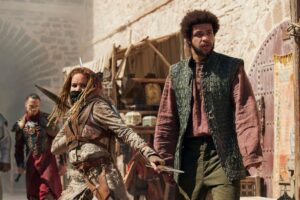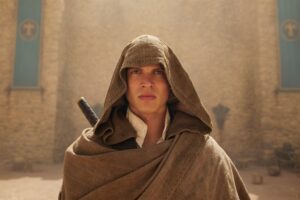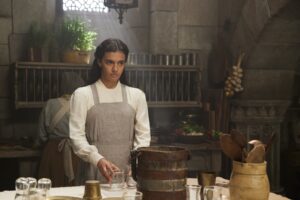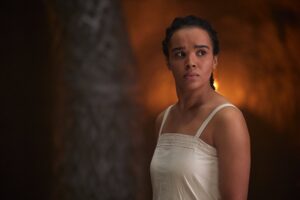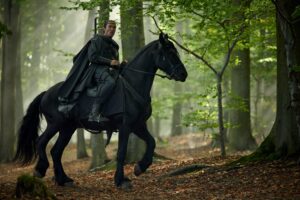This piece was written during the 2023 WGA and SAG-AFTRA strikes. Without the labor of the writers and actors currently on strike, the series being covered here wouldn’t exist.
The Wheel of Time turns, and ages come and pass, leaving memory that becomes legend. Legend fades to myth, and even myth is long forgotten when the Age that gave it birth comes again. In one Age, called the Third Age by some, an Age yet to come, an Age long past, a trailer dropped. The trailer was not the beginning; there are neither beginnings nor endings to the turning of the Wheel of Time. But it was a beginning.
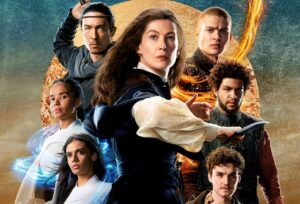
And what a beginning. The first official trailer for The Wheel Of Time season two doesn’t pull any punches. With how long it’s been since the first season aired on Prime Video (and how much fantasy television has come out since then, including HBO’s House Of The Dragon, Prime’s The Rings Of Power, and two seasons of Netflix’s The Witcher), the aim of this marketing campaign is to be as big, bold, and distinct as possible, practically slamming the viewer with epic visuals, dynamic action, thrilling drama, and iconic moments lifted straight from the pages of The Great Hunt and The Dragon Reborn, the second and third books in Robert Jordan’s best-selling series of high fantasy novels, supplemented in the show with enough new material to keep even veterans of the source material on the edge of their seats.
Of course, it would be significantly easier to promote the series with assistance from The Wheel Of Time‘s showrunner and actors, but that can’t happen until the AMPTP agrees to pay writers and actors what they’re worth. Until then, SAG-AFTRA and the WGA are both on strike, and The Wheel Of Time is just one of many upcoming releases that will have to rely heavily on its existing fanbase for the foreseeable future (all the more reason for fans to stay informed and stay wary, because Prime Video and other AMPTP member studios could very well approach you with offers to advertise struck work for them, and accepting such a deal at this time would be crossing a picket line). As long as you’re not being paid by a studio to do any of the following, then by all means, go ahead and make fan-art, fan-edits, fan-fiction, fan-covers of Wheel Of Time‘s music, and cosplays.
Cosplaying certain characters might be tricky for the average fan, though, with how ornate and elaborate the costumes have become in season two. I am on record as having been critical of costume designer Isis Mussenden’s work in the first season: I did not think the glory and gracefulness of the Aes Sedai was ever reflected in their brightly-colored but otherwise dully unostentatious clothing; Ishamael’s suit was shabby and poorly-tailored, hardly fit for a man posing as the Dark One himself; and the Seanchan to me looked like they had just walked off the set of a 1980s B-movie. Sharon Gilham (Jamestown, The Nun) replaced Mussenden as costume designer on seasons two and three – which started filming earlier this year in Prague – and although Mussenden’s designs are still the basis for some of what we see in season two, it is Gilham who has raised the bar for The Wheel Of Time, and for the fantasy genre in general, with the extraordinary wardrobe of high camp regalia she’s assembled for the Seanchan nobility and the Aes Sedai.
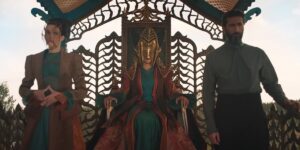
A few of my favorite costume details include the breastplate of woven bone forming a many-pronged pair of jaws around High Lord Turak’s head, the tusked golden latticework mask and crescent-moon headdress worn by High Lady Suroth, the frighteningly long bladed fingernails that mark them both as members of the Blood, and their pleated scale-patterned gowns in shades of teal and rust and vivid orange. Liandrin Guirale looks phenomenal in a red dress similar to one she wore throughout the first season, but darker, with a patterned leather harness. Siuan Sanche, the Amyrlin Seat, dons a new gilded shawl, a coat made of small gold discs, and a crown that I’m almost positive was made entirely from the kinds of beautiful debris you can pick up off the floor of an arts-and-crafts store: a smorgasbord of fabric flowers, metallic leaves, gold lace, and silver baubles that look magnificent when stitched together and placed on Sophie Okonedo’s brow. But of course, it’s Moiraine Damodred who makes the strongest impression, wearing a beautiful shirt of tight-knit white fabric under a blue silk robe with a bejeweled diadem in her hair, now hanging in loose ringlets after the fashion of Cairhien.
I could ramble on about the costumes and hairstyling for far longer than anyone would care to listen, so let me pivot real quick to locations, of which there are several. A time-jump of a few months means that very little time, if any, will be spent in the keep of Fal Dara where the first season ended, and it may be that the second season opens with Rand al’Thor already hiding out in the Foregate of Cairhien, with Moiraine and al’Lan Mandragoran hot on his heels, while the hunt for the Horn of Valere is already well underway, whisking Perrin Aybara and Loial off to the eastern boundaries of the known world, and Egwene al’Vere and Nynaeve al’Meara have begun their training at the White Tower, where Mat Cauthon is already a prisoner of the Red Ajah (there are some shots in the trailer that indicate Nynaeve may arrive at the Tower slightly later than Egwene, but unless she first spends time traveling with Moiraine and Lan, I can’t imagine why that would be, or why it would even make sense for an adaptation that’s trying to streamline the narrative as much as possible).
As much as I love Rand and Perrin and Moiraine, the few chapters of The Great Hunt that deal with Egwene and Nynaeve’s White Tower training have always been my favorites, and rereading the book recently (for the first time in years) reaffirmed that for me. Whenever the book jumped to Rand’s perspective or Perrin’s, I found myself impatiently yearning to be back at the Tower, exploring its nooks and crannies, learning about the One Power, or the differences between ter’angreal and sa’angreal, or the seven different Ajahs that make up the Aes Sedai. I love a story of political intrigue with magic involved, and that’s really what the White Tower arc boils down to – hundreds of morally dubious sorceresses scheming against each other. And the show being more of an ensemble piece than the early books means we can hopefully spend more time there, with the characters that make this world so unique.

The scene I’m looking forward to the most, that I hope is expanded on, is Nynaeve’s Accepted test. Novices at the White Tower typically study for several years, sometimes even decades, before they are deemed strong enough to take the test (and some never make it that far, or turn down the opportunity when it is offered) but those who survive earn the title of “Accepted” as well as a Great Serpent ring, and are put on the path to becoming Aes Sedai. Nynaeve’s power is so great that, in the books at least, she is rushed into her Accepted test before having any time to train as a Novice, and with only a vague understanding of what the test entails. The test takes place in the White Tower’s basement, where three silver arches stand on a dais, forming a massive ter’angreal that transports the user to alternate dimensions in which they must face literal manifestations of their worst fears and deepest desires. We see Nynaeve stumble out of the ter’angreal covered in blood, a reference to what Sheriam Bayanar only warns could happen in the book, that “some have come out bearing the actual wounds of hurts taken inside”.
At one point in the trailer we also see Egwene, still wearing the white uniform of a Novice, standing alone in the doorway to the testing room, channeling threads of the One Power as if she intends to unlock the ter’angreal. There’s a chance this is part of Nynaeve’s test (perhaps, instead of confronting the Forsaken Aginor as she does in the book, she must fight and kill a version of her friend, hence the blood on her hands?), but I think Egwene might just be reckless enough to try and take the test by herself, without guidance, after months of washing dishes and scrubbing floors as a Novice without learning anything she can use to help her friends who are in danger. Obviously she doesn’t succeed (because she’s still wearing Novice robes in later scenes), so maybe she gets lost in Tel’aran’rhiod, the World of Dreams, and has to rely on the sleepweaver ter’angreal given to her by Verin to escape? Just a theory, but it’d be a neat introduction to some concepts that will become extremely relevant in the next season.
There are a few other interesting shots of Egwene throughout the trailer, where you can see her wearing a gray tunic and golden collar, with bloodshot eyes and blood on her face, but I can’t say too much about what I think is happening there without spoiling one of The Great Hunt‘s most shocking twists, so I’ll just leave you with that piece of information to mull over instead. For similar reasons, I must refrain from sharing my theories as to what Liandrin is doing, hurrying through the streets of Tar Valon at night in a cloak and hood, or my many thoughts on the beautiful dark-haired woman hovering over Rand’s shoulder as he channels the One Power. If you know, you know.
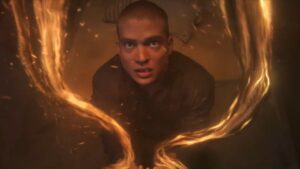
But as I mentioned, there’s some material in the trailer that’s not derived from the books at all. Moiraine and Siuan, the latter notably wearing blue (rather than Amyrlin gold), steal a kiss in a scene likely set prior to the birth of the Dragon Reborn, inspired by events covered in the Wheel Of Time prequel novel, New Spring. In the present day, Rand meets Siuan, not in Fal Dara where the two cross paths in the early chapters of The Great Hunt, but in what appears to be the Sun Palace of Cairhien; and in this version of events, Siuan has apparently brought the False Dragon Logain, still a prisoner of the Aes Sedai, to meet Rand and mentor him. Moiraine, shielded by Ishamael at the Eye of the World last season, sits miserably in a bath, unable to do so much as heat the water to her preferred temperature with the One Power (a poignant callback to an instantly iconic scene from The Wheel Of Time‘s first episode). And most controversially, Aviendha seems to take the place of Gaul, but I can’t even be mad about it because she looks so good dancing the spears.
While we’re on the subject, the fight choreography is another area where The Wheel Of Time has indisputably leveled up since the first season, and it’s a good thing too, because the finale did not (and arguably could not, due to COVID-19 restrictions in place at the time) deliver the brutal battle of epic proportions that was teased all season; and various smaller-scale action sequences earlier in the season, like the skirmish between the Aes Sedai and Logain’s rebels in episode four, while passable, never stood out for being particularly suspenseful, intense, or even clever on a conceptual level. With the introduction of the Seanchan and their army of brainwashed channelers called damane, weapons to be wielded in battle by handlers called sul’dam, that is unlikely to ever again be an issue for the show. The quick glimpses we’ve caught of both damane and sul’dam are equal parts horrific and fascinating.
Even with the Seanchan in the game, however, The Wheel Of Time‘s primary antagonist is still Ishamael, the mysterious man whose name is practically synonymous with that of the Dark One. His handsome face no longer hidden behind a CGI silken mask, actor Fares Fares seems to be making the most of this opportunity to be both delectably evil and suave as he hosts social gatherings for Darkfriends and Forsaken – a rogues gallery of ancient villains with colorful personalities, whittled down in the show from thirteen to just eight of the most significant. Ishamael is their leader, but second behind him in all the horror-stories that survived the Breaking of the World is Lanfear, Daughter of the Night, and it’s probably her bloody naked body we see rising stiffly from the floor of a cave in the trailer. Few things would give me greater joy out of this adaptation than a genuinely nightmare-inducing depiction of Lanfear, who has been mischaracterized as a cartoonish “crazy ex-girlfriend” archetype for so long that I think Jordan at some point started writing her like that, and fans have all but forgotten she’s responsible for drilling a hole in the fabric of reality and releasing the Dark One in the first place.
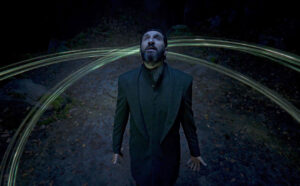
I have high hopes for this season to be better than the first and better than the book(s) it’s based on by a substantial margin, which is exactly what I predicted when I wrote that the season finale was only as messy as it was so that season two wouldn’t have to be. After momentarily steering off-course in the wake of Barney Harris’ departure and the COVID-19 pandemic, The Wheel Of Time is back on-track to be mentioned in the same breath as House Of The Dragon and The Witcher season three as some of the best fantasy television on the air (The Rings Of Power deserves to be up there too for its visuals, score, and excellent performances, but that series’ writing needs refinement in its own highly-anticipated second season). Hopefully they can keep that momentum going and get the fourth, fifth, sixth, seventh and eighth seasons that we’ll need to finish this epic story, because this? This is just a beginning.
Trailer Rating: 9/10
